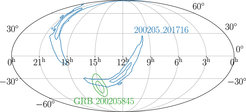Long gamma-ray bursts and gravitational waves: Are they connected?
The first multi-messenger search for long gamma-ray bursts associated with gravitational-wave binary coalescence events
Gamma-ray bursts are categorized as either short or long according to their duration. Short gamma-ray bursts are thought to originate from binary neutron star mergers, while long gamma-ray bursts are associated with the collapse of massive stars. On 11 December 2021, the strange gamma-ray burst event GRB 211211A was observed: It lasted 50 seconds, but a kilonova was detected indicating that a neutron star merger was involved. This event contradicts the conventional understanding and suggests gravitational waves may be a possible multi-messenger association for long gamma-ray bursts resulting from neutron star mergers. Researchers from the Max Planck Institute for Gravitational Physics in Hannover have now for the first time searched archival data from 2015 to 2020 for multi-messenger signals of this type using a Bayesian framework to determine the association. The most significant candidate identifed only has a once-every-two-years false alarm rate, making it consistent with random noise fluctuations. Nonetheless, the search results are utilized to obtain limits for distances of the relevant sources.
Paper abstract

The recent discovery of a kilonova associated with an apparent long-duration gamma-ray burst has challenged the typical classification that long gamma-ray bursts originate from the core collapse of massive stars and short gamma-ray bursts are from compact binary coalescence. The kilonova indicates a neutron star merger origin and suggests the viability of gravitational-wave and long gamma-ray burst multimessenger astronomy. Gravitational waves play a crucial role by providing independent information for the source properties. This work revisits the archival 2015–2020 LIGO/Virgo gravitational-wave candidates from the 4-OGC catalog that are consistent with a binary neutron star or neutron star–black hole merger and the long-duration gamma-ray bursts from the Fermi-GBM and Swift-BAT catalogs. We search for spatial and temporal coincidence with up to a 10 s time lag between gravitational-wave candidates and the onset of long-duration gamma-ray bursts. The most significant candidate association has only a false-alarm rate of once every 2 yr; given the LIGO/Virgo observational period, this is consistent with a null result. We report an exclusion distance for each search candidate for a fiducial gravitational-wave signal with conservative viewing angle assumptions.












